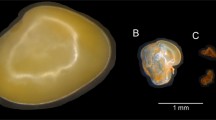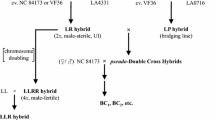Abstract
Reproductive abnormalities reduced the percent stainable pollen, and fruit and seed set in interspecific F2 populations derived from crosses of Lycopersicon esculentum and L. pennellii but were not observed in parental lines and interspecific F1 populations. The degree to which these reproductive abnormalities were expressed in the interspecific F2 populations was affected by cytoplasm. Reproduction was impeded in interspecific F2 populations containing L. esculentum cytoplasm (F Le2 ) by reduction in pollen production, the lack of fruit set and a high proportion of parthenocarpic fruit among plants capable of fruit set. The F2 populations containing L. pennellii cytoplasm (F Lp42 ) showed a reduced frequency of reproductive abnormalities at all stages of reproductive development, resulting in higher values for percent stainable pollen, fruit and seed set and higher proportions of the F Lp42 populations being capable of setting fruit or seed than F Le2 populations. The major barrier remaining in F Lp42 populations was reduced fruit set compared to parental lines. The barrier to fruit and seed set observed in the F Le2 populations, and to a lesser extent in the F Lp42 populations, occurs around the time of fertilization or early embryonic development. The effect of L. pennellii cytoplasm on barriers in the F Lp42 populations is proposed to be due to an interaction between cytoplasmic and nuclear genes during fertilization of the F1 plants to produce F2 populations and may also affect subsequent generations.
Similar content being viewed by others
References
Alexander MP (1969) Differential staining of aborted and non-aborted pollen. Stain Technol 44:117–122
Andersen WR (1963) Cytoplasmic sterility in hybrids of Lycopersicon esculentum and Solanum pennellii. Rep Tomato Genet Coop 13:7–8
Ascher PD (1986) Incompatibility and incongruity: two mechanisms preventing gene transfer between taxa. In: Mulcahy DL, Mulcahy GB, Ottaviano E (eds) Biotechnology and ecology of pollen. Springer, Berlin Heidelberg New York, pp 251–256
Association of Official Seed Analysts (1988) Rules for testing seeds. J Seed Technol 12:121–122
Bannikova VP, Khvedynich OA (1974) Features of fertilization in the course of remote hybridization of plants. In: Linskens EF (ed) Fertilization in higher plants. Proceedings of the International Symposium Fertilization in Higher Plants. Elsevier, New York, pp 301–310
Barbano PP, Topoleski LD (1984) Postfertilization hybrid seed failure in Lycopersicon esculentumxLycopersicon peruvianum ovules. J Am Soc Hort Sci 109:95–100
Boodley JW, Sheldrake JJ (1982) Cornell peat-like mixes for commercial plant growing. Information Bulletin no 43. Cornell Cooperative Extension, Cornell University, Ithaca, NY
Brewbaker JL, Kwack BH (1963) The essential role of calcium ion in pollen germination and pollen tube growth. Am J Bot 50:859–865
Choudhury B (1959a) Development of seed and its parts. Hybrid seed of Lycopersicon esculentum and Lycopersicon peruvianum. Indian J Hortic 16:23–30
Choudhury B (1959b) Hybridization between Lycopersicon esculentum Mill. and Lycopersicon peruvianum Mill. Indian J Hortic 16:102–107
Clausen J (1951) Evolution of interspecific barriers. In: Clausen J (ed) Stages in the evolution of plant species. Cornell University Press, Ithaca, pp 87–121
Clausen J, Keck DD, Hiesey WM (1940) The genus Zauschneria. In: Clausen J, Keck DD, Hiesey WM (eds) Experimental studies on the nature of species. I. Effect of varied environments on western North American plants. Gibson, Washington, DC, pp 247–259
Cooper DC (1927) Anatomy and development of tomato flower. Bot Gaz 83:399–411
Cooper DC, Brink RA (1945) Seed collapse following matings between diploid and tetraploid races of Lycopersicon pimpinelifolium. Genetics 30:376–400
Correll DS (1958) A new species and some nomenclatural changes in Solanum, section Tuberarium. Madrono 14:232–236
Cutler HC, Whitaker TW(1969) A new species of Curcurbitat from Ecudora. Ann Mol Bot Gard 55:392–396
Fahn A (1982) Plant anatomy. Pergamon Press, Oxford
Flaschenriem DR (1974) A new method of producing Petunia hybrida seed in vitro. MS thesis, Mankato State College, Mankato, Minn
Gradziel TM, Okada M, St. Clair DA (1993) Pollen-tube hypertrophy in ovules of Solanum and Lycopersicon following interspecific crosses. Sex Plant Reprod 6:147–152
Hadley HH, Openshaw SJ (1980) Interspecific and intergeneric hybridization. In: Fehr WR, Hadley HH (eds) Hybridization of crop plants. American Society of Agronomy and Crop Science Society of America, Madison, Wis, pp 133–159
Haghighi KR, Ascher PD (1988) Fertile, intermediate hybrids between Phaseolus vulgaris and P. acutifolius from congruity backcrossing. Sex Plant Reprod 1:51–58
Hanson MR, Conde MF (1985) Functioning and variation of cytoplasmic genomes: lessons from cytoplasmic nuclear interactions affecting male fertility in plants. Int Rev Cytol 94:213–267
Hogenboom NG (1972) Breaking breeding barriers in Lycopersicon. 4. Breakdown of unilateral incompatibility between L. peruvianum (L.) Mill. and L. esculentum Mill. Euphytica 21:397–404
Kaul MLH (1988) Male sterility in higher plants. Springer, Berlin Heidelberg New York
Kho YO, Baer J (1968) Observing pollen tubes by means of fluorescence. Euphytica 17:298–302
Khush GS, Rick CM (1963) Meiosis in hybrids between Lycopersicon esculentum and Solanum pennellii. Genetica 33:167–183
Knox RB (1984) Pollen-pistil interactions. In: Linskens HF, Heslop-Harrison J (eds) Cellular Interactions. Springer, Berlin Heidelberg New York, pp 508–608
Linskens HF (1974) Why fertilization research? In: Linskens HF (ed) Fertilization in higher plants. Proceedings of the International Symposium Fertilization in Higher Plants. Elsevier, New York, p xiii
MacArthur JW, Chiasson LP (1947) Cytogenetic notes on tomato species and hybrids. Genetics 32:163–177
MINITAB I (1991) MINITAB. Minitab, Inc., State College, Pa
Mutschler MA (1990) Transfer of Lycopersicon pennellii cytoplasm into tomato (L. esculentum) does not create cytoplasmic male sterility. Rep Tomato Genet Coop 40:25–26
Mutschler MA, Liedl BE (1994) Interspecific crossing barriers in Lycopersicon and their relationship to self-incompatibility. In: Williams EG, Clarke AE, Knox RB (eds) Genetic control of self-incompatibility and reproductive development in flowering plants. Kluwer, Dordrecht, pp 164–188
Rick CM (1960) Hybridization between Lycopersicon esculentum and Solanum pennellii: phylogenetic and cytogenetic significance. Proc Natl Acad Sci USA 46:78–82
Rick CM (1963) Differential zygotic lethality in a tomato species hybrid. Genetics 48:1497–1507
Rick CM (1969) Controlled introgression of chromosomes of Solanum pennellii into Lycopersicon esculentum: segregation and recombination. Genetics 62:753–768
Rick CM (1991) Tomato paste: a concentrated review of genetic highlights from the beginnings to the advent of molecular genetics. Genetics 128:1–5
Rick CM, Hunt D (1961) Improved seed germination with the use of sodium hypochlorite. Rep Tomato Genet Coop 11:22
Rick CM, Lamm R (1955) Biosystematic studies on the status of Lycoperiscon chilense. Am J Bot 42:663–675
Rick CM, Kesicki E, Fobes JF, Holle M (1976) Genetic and biosystematic studies on two new sibling species of Lycopersicon from Interandean Peru. Theor Appl Genet 47:55–68
Smith JA, Desborough SL (1986) An interpretation of genomic balance in seed formation in interspecific hybrids of Solanum. Theor Appl Genet 72:346–352
Smith PG (1944) Embryo culture of a tomato species hybrid. Proc Am Soc Hortic Sci 44:278–288
Smith SE (1989) Biparental inheritance of organelles and its implications in crop improvement. Plant Breed Rev 6:361–393
Stephens SG (1950) The internal mechanism of speciation in Gossypium. Bot Rev 16:115–149
Tanksley SD, Ganal MW, Prince JP, Vincente MC de, Bonierbale MW, Broun P, Fulton FM, Giovannoni JJ, Grandillo S, Martin GB, Messeguer R, Miller JC, Miller L, Paterson AH, Pineda O, Roder MS, Wing RA, Wu W, Young ND (1992) High density molecular linkage maps of the tomato and potato genomes. Genetics 132:1141–1160
Weeden N, Robinson RW (1986) Allozyme segregation ratios in the interspecific cross Curcurbita maxima and C. ecuadorensis suggest that hybrid breakdown is not caused by minor alterations in chromosome structure. Genetics 114:593–609
Author information
Authors and Affiliations
Rights and permissions
About this article
Cite this article
Liu, S.C., Liedl, B.E. & Mutschler, M.A. Alterations of the manifestations of hybrid breakdown in Lycopersicon esculentum L. pennellii F2 populations containing L. esculentum versus L. pennellii cytoplasm. Sexual Plant Reprod 8, 361–368 (1995). https://doi.org/10.1007/BF00243204
Received:
Accepted:
Issue Date:
DOI: https://doi.org/10.1007/BF00243204




